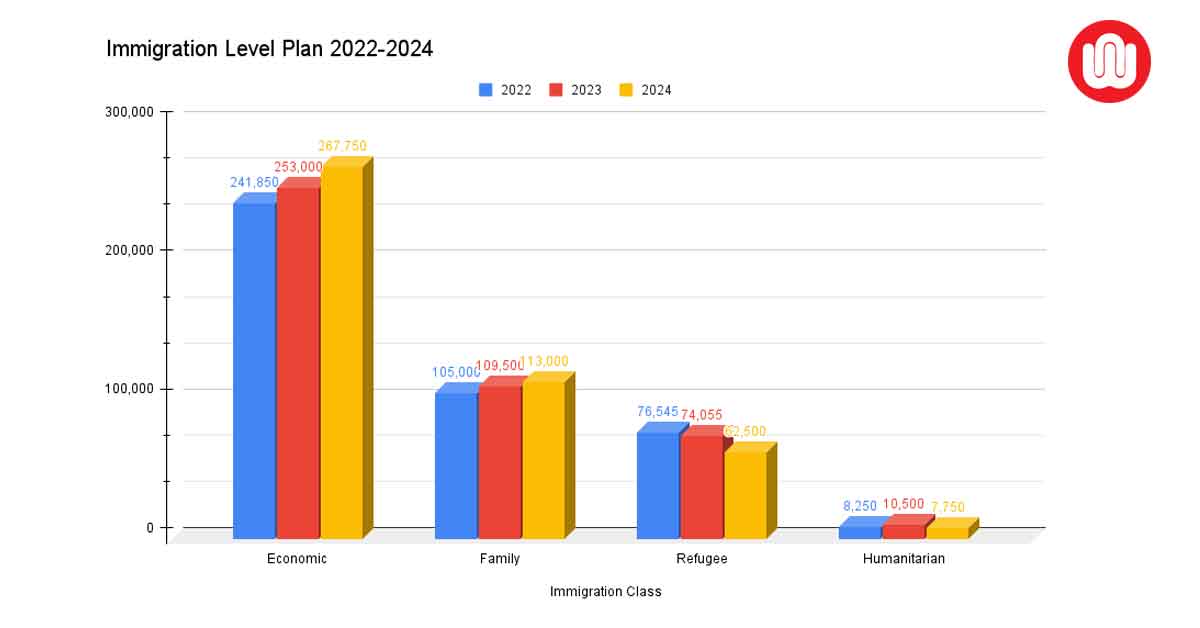
“The Canadian government increases its admission intake yet again – as it sets off to welcome 451,000 new immigrants by 2024 under its new immigration level plan.”
Revamping its initial target to welcome 411,000 new immigrants, Canada will now seek to welcome around 432,000 new immigrants this year. Over the coming three years, Canada aims to achieve the following number of new immigration intake.
As stated by Immigration Minister Sean Fraser in a press release, the new level plan is designed to support and sustain the country's demands and its international responsibilities. It will seek to attract skilled and experienced workers who can effectively and efficiently - contribute to Canada's economy, as well as acknowledge the value of family sponsorship and refugee resettlement programs. The Canadian government aims to boost the country’s economic recovery by increasing newcomer retention in areas where it faces significant economic, labor, and demographic shortages.
In 2022, Canada will welcome around 56% of new immigrants under its primary economic class programs such as Express Entry, Provincial Nominee Program (PNP), and Temporary Residence to Permanent Residence (TR 2 PR).
The Provincial Nominee Programs will play a significant role in the revamped level plan – where the Immigration, Refugees, and Citizenship Canada (IRCC) will aim to land 83,500 aspiring immigrants in the year 2022.
The IRCC also stated that it will put in immense efforts to bring the Express Entry admission levels back to normal by 2024 – as they had to cut it down to half this year, owing to the COVID-19 pandemic. This reduction in Express Entry admissions vaguely indicated that the IRCC is looking to shine a light on the TR2PR program, where it seeks to admit 40,000 immigrants in 2022 and 32,000 immigrants by 2023.
As of now, the IRCC continues to process Express Entry applications with the help of its immigration draws held on a bi-weekly basis. Canada’s provinces and territories have also been issuing invitations throughout the pandemic.
Coming in on second with 24% admission targets - Canada’s family class programs will also be of great importance in this new immigration level plan. Canada is all set to welcome 80,000 immigrants under the Spouses, Partners, and Children Program and 25,000 under the Parents and Grandparents Program (PGP).
With an increase of about 5% - the remaining 20% of immigrants will arrive under refugees and humanitarian programs. The increase in the number of admission intakes owns to the fact that Canada is looking to resettle almost 40,000 Afghan refugees over the coming three years.

Every year, the IRCC releases a new immigration level plan that helps achieve its intake targets. But, owning to the pandemic - and the September elections last year, this announcement was the first one since October 2020.
There is no denying the fact that immigration-level plans are the backbone of the Canadian immigration system. Such plans showcase the number of immigrants to be welcomed under popular federal, provincial, and territorial programs. The IRCC effectively curates a level plan every year to ensure that the immigration targets are met in a hassle-free process.
Back in 2015 and 2016, the admission targets had a relatively lower baseline of 250,000-300,000 newcomers annually. Prior to the pandemic in 2020, the target was increased to about 340,000 immigrants per year – but owning to the COVID-19 pandemic, the IRCC only managed to welcome 200,000 out of the expected 340,000 immigrants.
It was because of this drastic decrease in the number that the Canadian government decided to boost its immigration intake to 400,000. This surprise announcement was intended to help support Canada’s post-pandemic recovery.
In 2021, Canada set a new record by inviting 405,000 new permanent residents to the country. 62% of the immigration application applications were processed under federal and economic pathways such as Express Entry, PNP, and Quebec streams. 20% of the total were welcomed under the Spouses, Partners, and Children Program and the Parents and Grandparents Program. Whereas, 15% were invited under the refugees and humanitarian programs.

The increase in intake level this year, and in 2021 – was intended to support and sustain Canada’s economy. It is because of the aging population and low birth rate – such high numbers are important to stabilize the country’s population.
Being a nation built by immigrants, immigration undoubtedly plays a crucial part in Canada’s ever-growing development.
Need more insights on the same? Get in touch with an ICCRC authorized immigration consultant at Nationwide Visas today!
Related Posts
Enquire Now
How to Bring your Parents to Canada?
02 Feb, 2023 | 04:57 PM 3231495
Is Canada a Better Place to Live than the UK?
08 Sep, 2022 | 03:50 PM 184826
What's the next step after biometrics for Canada Study Visa?
16 Jun, 2022 | 05:44 PM 159051
How much funds are required for a Study Visa in Canada?
11 May, 2022 | 11:43 AM 150090
How to get a job in UK from India?
03 Jun, 2022 | 12:31 PM 144049
How to move to Canada with family from Dubai, UAE?
19 Apr, 2025 | 06:47 AM 3717
Top 5 ways to move to Canada from Dubai, UAE
16 Apr, 2025 | 06:05 PM 8175
How much does it cost to immigrate to Canada from the UAE?
14 Apr, 2025 | 04:52 AM 12114
Top 7 Provinces in Canada for UAE Expats
12 Apr, 2025 | 06:19 PM 13433
How to Apply for Canada Express Entry from Dubai?
11 Apr, 2025 | 10:48 AM 15374
Stay up to date with latest news
Comments
We welcome your feedback
Your email address will not be published. Required fields are marked *